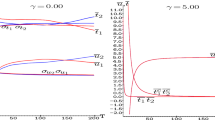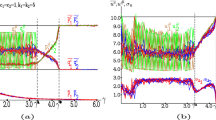Abstract
This work studies the quantum Hotelling game via spatial numerical simulation. It is concluded that entanglement enables the emergence of the Pareto optimal solution in Nash equilibrium in simulations of the game with variable prices and fixed location of the players. In the rather complicated scenario of variable prices and locations, the implemented simulation technique shows that the players share the market, both locating close to (L/4, 3L/4). The Hotelling game is studied with both linear and quadratic transportation cost, with no relevant discrepancies found in both scenarios.






























Similar content being viewed by others
Notes
\( p_2^c-p_1^c =p_2w_1+p_1w_2-(p_1w_1+p_2w_2)= p_2(w_1-w_2) -p_1(w_1-w_2)=(p_2-p_1)(w_1-w_2).\)
\(u_1^c=p_1^c(Q_1(\gamma )={{\overline{s}}}(\gamma ))\), \(u_2^c=p_2^c(Q_2(\gamma )=(L-{{\overline{s}}}(\gamma )))\), \(\partial {{u_1(\gamma )}}{{p_1}}=0\,\cap \,\partial {{u_2(\gamma )}}{{p_2}}=0 \rightarrow p_1^\star (\gamma ),p_2^\star (\gamma ).\)
\(e(s)=\alpha \rightarrow p_1^c+(s-a)t=\alpha ,\, p_2^c+(L-b-s)t=\alpha , \rightarrow p_1^c+p_2^c=2\alpha -(L-b-a)t \rightarrow (p_1+p_2)(w_1+w_2)=h\). \(\frac{p_1}{p_2}=\frac{L+k(\gamma )}{L-k(\gamma )} \rightarrow (p_1+ \frac{L-k(\gamma )}{L+k(\gamma )}p_1)(w_1+w_2)=h,\,\, p_1(\frac{2L}{L+k(\gamma )})(w_1+w_2)=h\,.\)
\(\gamma \ge \gamma ^\bullet :\, p_2^\star (\gamma )-p_1^\star (\gamma )= \frac{he^{-\gamma }}{2L}[-2k(\gamma )]t\).
 .
.\(\frac{1}{2}\big (L +\frac{a-b}{2+e^{2\gamma }}\big )=\frac{1}{2}\big (L+a-b - \frac{h(a-b)}{L(2+e^{2\gamma })}\big )\Rightarrow \) \( \frac{a-b}{2+e^{2\gamma }} = a-b - \frac{h(a-b)}{L(2+e^{2\gamma })} \Rightarrow \) \( \frac{1}{2+e^{2\gamma }} = 1 - \frac{h}{L(2+e^{2\gamma }(} \Rightarrow \) \( 1 = 2+e^{2\gamma } - \frac{h}{L} \Rightarrow \) \( e^{2\gamma }= \frac{h}{L}-1\,.\)
Both \({{\overline{s}}}^\star (\gamma )\) formulas equalize at \(\gamma =\gamma ^\bullet \) : \(\frac{1}{2}\big (L +\frac{a-b}{2+e^{2\gamma }}\big )=\frac{1}{2}\big (L+a-b - \frac{h(a-b)}{L(2+e^{2\gamma })(x_2-x_1)}\big )\Rightarrow \) \( \frac{a-b}{2+e^{2\gamma }} = a-b - \frac{h(a-b)}{L(2+e^{2\gamma })(x_2-x_1)} \Rightarrow \) \( \frac{1}{2+e^{2\gamma }} = 1 - \frac{h}{L(2+e^{2\gamma })(x_2-x_1)} \Rightarrow \) \( 1 = 2+e^{2\gamma } - \frac{h}{x_2-x_1} \Rightarrow \) \( e^{2\gamma }= \frac{h}{L(x_2-x_1)}-1\,.\)
\( p_2^c-p_1^c =p_2w_1(\gamma )+p_1w_2(\gamma )-(p_1w_1(\gamma )+p_2w_2(\gamma ))= p_2(w_1(\gamma )-w_2(\gamma )) -p_1(w_1(\gamma )-w_2(\gamma ))=(p_2-p_1)(w_1(\gamma )-w_2(\gamma )), w_1(\gamma )-w_2(\gamma )= \cos ^2\gamma -\sin ^2\gamma =\cos 2\gamma \).
Both \({{\overline{s}}}^\star (\gamma )\) formulas equalize at \(\gamma =\gamma ^\bullet \) : \(\frac{1}{2}\big (L+a-b-2\frac{\cos ^2\gamma }{\cos 2\gamma }k(\gamma )\big )=\frac{1}{2}\big (L+a-b-\frac{h}{L}k(\gamma )\big )\Rightarrow \) \( 2\frac{\cos ^2\gamma }{\cos 2\gamma } = \frac{h}{L} \Rightarrow \) \( \frac{\cos ^2\gamma -\sin ^2\gamma }{\cos ^2\gamma } = \frac{2L}{h} \Rightarrow \) \( 1-\tan ^2 \gamma = \frac{2L}{h}\,. \)
References
Alonso-Sanz, R., Adamatzky, A.: Cellular automaton simulation of the quantum war of attrition game. Quantum Inf. Process. 19(10), 1–20 (2020)
Alonso-Sanz, R., Adamatzky, A.: Spatial simulation in the quantum Bertrand duopoly game. Physica A 557, 124867 (2020)
Alonso-Sanz, R., Martin-Gutierrez, S.: The free-rider in the quantum Stackelberg duopoly game. Physica A 554, 124271 (2020)
Alonso-Sanz, R.: Simulation of the quantum Cournot duopoly game. Physica A 534, 122116 (2019)
Alonso-Sanz, R.: Quantum Game Simulation. Springer, Berlin (2019)
Alonso-Sanz,R.(2017). Spatial correlated games. Royal Society Open Science, 4,6,171361
d’Aspremont, C., Gabszewicz, J.J., Thisse, J.F.: On Hotelling’s “Stability in competition’’. Econometrica 47(5), 1145–1150 (1979)
Chen, Y., Qin, G., Wang, A.M.: Quantization of the Location Stage of Hotelling Model. arXiv preprint arXiv:1410.2779 (2014)
Du, J., Ju, C., Li, H.: Quantum entanglement helps in improving economic efficiency. J. Phys. A Math. General 38(7), 1559 (2005)
Economides,N.(1993). Hotelling’s ’Main Street’ with more than two competitors. Journal of Regional Science,33(3), 303-319
Eisert, J., Wilkens, M., Lewenstein, M.: Quantum games and quantum strategies. Phys. Rev. Lett. 83(15), 3077–3080 (1999)
Frackiewicz, P.: Remarks on quantum duopoly schemes. Quantum Inf. Process. 15(1), 121–136 (2016)
Hinloopen, J., Van Marrewijk, C.: On the limits and possibilities of the principle of minimum differentiation. Int. J. Ind. Organ. 17(5), 735–750 (1999)
Hotelling, H.: Stability in competition. Econ. J. 39(153), 41–57 (1929)
Iqbal, A., Chappell, J.M., Abbott, D.: On the equivalence between non-factorizable mixed-strategy classical games and quantum games. R. Soc. Open Sci. 3, 150477 (2016)
Li, H., Du, J., Massar, S.: Continuous-variable quantum games. Phys. Lett. A 306, 73–78 (2002)
Lerner, A.P., Singer, H.W.: Some notes on duopoly and spatial competition. J. Political Econ. 45(2), 145–186 (1937)
Lo, C.F., Kiang, D.: Quantum Stackelberg duopoly. Phys. Lett. A 318, 333–336 (2003)
Lo, C.F., Kiang, D.: Quantum Bertrand duopoly with differentiated products. Phys. Lett. A 321(2), 94–98 (2004)
Rahaman, R., Majumdar, P., Basu, B.: Quantum Cournot equilibrium for the Hotelling-Smithies model of product choice. J. Phys. A Math. Theor. 45(45), 455301 (2012)
Wolfram, S.: A New Kind of Science. Wolfram Media, Champaign (2002)
Acknowledgements
This work has been funded by the Spanish Grant PGC2018-093854-B-I00. The computations of this work were performed in FISWULF, an HPC machine of the International Campus of Excellence of Moncloa, funded by the UCM and Feder Funds.
Author information
Authors and Affiliations
Corresponding author
Additional information
Publisher's Note
Springer Nature remains neutral with regard to jurisdictional claims in published maps and institutional affiliations.
Rights and permissions
About this article
Cite this article
Garcia, L., Grau, J., Losada, J.C. et al. Cellular automaton simulation of the quantum Hotelling game with reservation cost. Quantum Inf Process 20, 227 (2021). https://doi.org/10.1007/s11128-021-03132-x
Received:
Accepted:
Published:
DOI: https://doi.org/10.1007/s11128-021-03132-x





 .
.